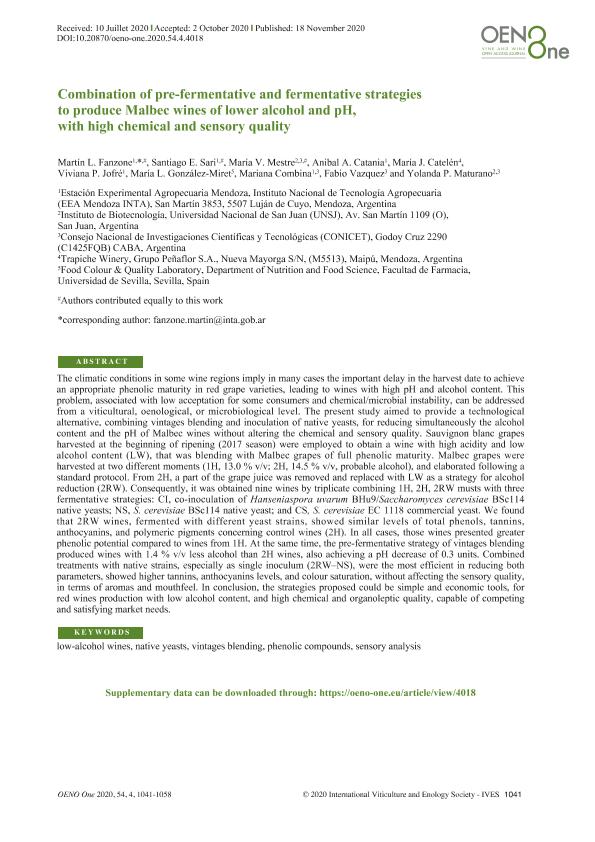Artículo
Combination of pre-fermentative and fermentative strategies to produce Malbec wines of lower alcohol and pH, with high chemical and sensory quality
Fanzone, Martín Leandro; Sari, Santiago Eduardo; Mestre Furlani, María Victoria ; Catania, Anibal Alejandro; Catelén, María J.; Jofre, Viviana Patricia; González Miret, María L.; Combina, Mariana
; Catania, Anibal Alejandro; Catelén, María J.; Jofre, Viviana Patricia; González Miret, María L.; Combina, Mariana ; Vazquez, Fabio; Maturano, Yolanda Paola
; Vazquez, Fabio; Maturano, Yolanda Paola
 ; Catania, Anibal Alejandro; Catelén, María J.; Jofre, Viviana Patricia; González Miret, María L.; Combina, Mariana
; Catania, Anibal Alejandro; Catelén, María J.; Jofre, Viviana Patricia; González Miret, María L.; Combina, Mariana ; Vazquez, Fabio; Maturano, Yolanda Paola
; Vazquez, Fabio; Maturano, Yolanda Paola
Fecha de publicación:
11/2020
Editorial:
International Viticulture and Enology Society
Revista:
Oeno One
ISSN:
2494-1271
Idioma:
Inglés
Tipo de recurso:
Artículo publicado
Clasificación temática:
Resumen
The climatic conditions in some wine regions imply in many cases the important delay in the harvest date to achieve an appropriate phenolic maturity in red grape varieties, leading to wines with high pH and alcohol content. This problem, associated with low acceptation for some consumers and chemical/microbial instability, can be addressed from a viticultural, oenological, or microbiological level. The present study aimed to provide a technological alternative, combining vintages blending and inoculation of native yeasts, for reducing simultaneously the alcohol content and the pH of Malbec wines without altering the chemical and sensory quality. Sauvignon blanc grapes harvested at the beginning of ripening (2017 season) were employed to obtain a wine with high acidity and low alcohol content (LW), that was blending with Malbec grapes of full phenolic maturity. Malbec grapes were harvested at two different moments (1H, 13.0 % v/v; 2H, 14.5 % v/v, probable alcohol), and elaborated following a standard protocol. From 2H, a part of the grape juice was removed and replaced with LW as a strategy for alcohol reduction (2RW). Consequently, it was obtained nine wines by triplicate combining 1H, 2H, 2RW musts with three fermentative strategies: CI, co-inoculation of Hanseniaspora uvarum BHu9/Saccharomyces cerevisiae BSc114 native yeasts; NS, S. cerevisiae BSc114 native yeast; and CS, S. cerevisiae EC 1118 commercial yeast. We found that 2RW wines, fermented with different yeast strains, showed similar levels of total phenols, tannins, anthocyanins, and polymeric pigments concerning control wines (2H). In all cases, those wines presented greater phenolic potential compared to wines from 1H. At the same time, the pre-fermentative strategy of vintages blending produced wines with 1.4 % v/v less alcohol than 2H wines, also achieving a pH decrease of 0.3 units. Combined treatments with native strains, especially as single inoculum (2RW–NS), were the most efficient in reducing both parameters, showed higher tannins, anthocyanins levels, and colour saturation, without affecting the sensory quality, in terms of aromas and mouthfeel. In conclusion, the strategies proposed could be simple and economic tools, for red wines production with low alcohol content, and high chemical and organoleptic quality, capable of competing and satisfying market needs.
Archivos asociados
Licencia
Identificadores
Colecciones
Articulos(CCT - MENDOZA)
Articulos de CTRO.CIENTIFICO TECNOL.CONICET - MENDOZA
Articulos de CTRO.CIENTIFICO TECNOL.CONICET - MENDOZA
Articulos(CCT - SAN JUAN)
Articulos de CENTRO CIENTIFICO TECNOLOGICO CONICET - SAN JUAN
Articulos de CENTRO CIENTIFICO TECNOLOGICO CONICET - SAN JUAN
Citación
Fanzone, Martín Leandro; Sari, Santiago Eduardo; Mestre Furlani, María Victoria; Catania, Anibal Alejandro; Catelén, María J.; et al.; Combination of pre-fermentative and fermentative strategies to produce Malbec wines of lower alcohol and pH, with high chemical and sensory quality; International Viticulture and Enology Society; Oeno One; 54; 4; 11-2020; 1041-1058
Compartir
Altmétricas



